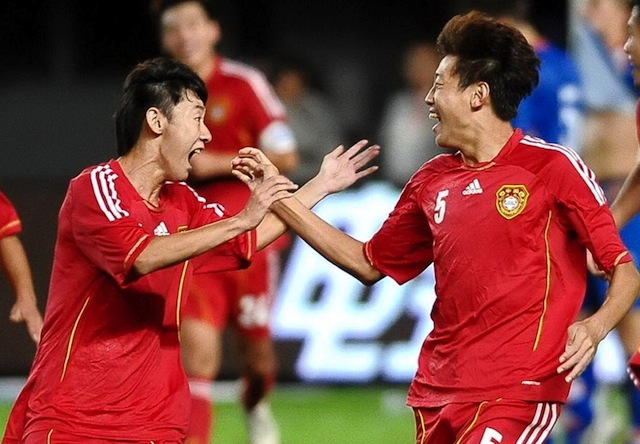Youth football in China is a topic that has been discussed a lot and, following last weeks’ Under-16 and Under-19 national team fixtures, it is an issue that has been highlighted once more. First off, while defeat to South Korea in the final game of the Qinhuangdao Invitational was disappointing, it is also important to note that the Under-19 side achieved good results against both Croatia and Mexico—albeit neither country’s strongest side.
Having experience in scouting, I was interested to see how China would match up against three strong opponents and the results were incredibly revealing. As ever, there is talent in the system that should go on to achieve much at first-team level, but there is a frustrating lack of development in terms of tactics and attitude.
The side set up as most CSL clubs would in a 4-2-3-1, with left-sided attacking midfielder Wei Shihao closer to the forward line while Cheng Jin tucked in on the right to offer more midfield strength. There was a desire to pass the ball, particularly in the fixture with Croatia—which was encouraging to see—but all too often there seemed to be a lack of a plan when in possession. The ball would simply be played among the defenders until they were closed down, at which point they would look to play a long diagonal to one of the forward players. As a result, most of China’s attacking threat either came from set pieces or a moment of individualism on the ball.
The problem, as has been the case with the senior side on many occasions, lay in defensive midfield. Chinese coaches are quick to emphasise strength and power, which they often see as prerequisites for midfielders. The result is that, while the defence has a solid platform, there is little fluidity when in possession of the ball. On this occasion, Min Quanxin and Duan Yunzi both performed reasonably well without the ball, closing players down, making tackles and protecting the back four. Neither, though, showed particular comfort with the ball at their feet and the same could be said of both full-backs who were largely unambitious.
It is a problem based upon coaching from an early age. Players are not given enough technical coaching and are thus limited in their options when in possession, while their tactical understanding is also not at the level of their opponents. It is clear that the Chinese side have been taught to play mechanically, rather than to make decisions based on the scenario, meaning it can all become very predictable. It is a problem visible in the Super League every week.
National team head coach Fu Bo recently spoke of his desire to see China passing the ball more and, at the East Asian Cup, it was clear that he had instructed his full-backs to attack, the centre-backs to split and one of the midfielders to drop back and collect the ball from the goalkeeper. It is a style of play now common in Europe and, given that the national side studied video of Barcelona, that is likely the inspiration for the change. That system, though, needs to be implemented from the youngest age groups up if players are to become fully comfortable with the requirements. In this side, neither Min or Duan appears comfortable distributing the ball or retaining the ball in midfield, meaning that the midfield is bypassed when attacking.
There were, though, positives to take from the week. Centre-backs Gao Zhunyi and Liu Haidong both played well, with Liu the better of the duo. If they can both work on their distribution and comfort with the ball at their feet, they should go on to enjoy decent careers. Centre-forward Xiang Baixu, meanwhile, is a tall, powerful target man and could be of use to China in future years, given the lack of natural No. 9s in the country, while Cheng Jin could perhaps be a candidate for a more central role if they were to venture towards a more modern playing style.
The two real stars, though, were the Shandong Luneng pair of Wei Shihao and Wang Jinxian. Wei Shihao, who played from the left flank, was the team’s one real flash of creativity for the first two games and was missed against Korea. With good dribbling skills, speed across the ground and a powerful shot, he looks to have all the basic attributes required to be a leading Chinese player in the future. He has spent time in Portugal and, indeed, there are rumours that he is set to join Boavista—where he is already registered with the Portuguese FA. Shandong, though, should endeavour to keep him in China and hand him first-team football.
Wang Jinxian, a tall but slight second striker, also showed flashes of impressive technique and footballing talent. He linked play well, collecting the ball off the No. 9 and looking to bring the side’s wide players into the game, but like Wei Shihao was left with too little support from the centre of midfield. With playing time, there is no doubt that both Wei and Wang would learn from Radomir Antic and some of Shandong’s impressive attacking players. If they are both forced to wait another two years before opportunities arrive, however, it is too late.
There were positives to take away from the tournament, ahead of next month’s Asian Championship qualifiers, but also many questions that the Chinese football organisers must resolve to maximise the footballing potential of their current youngsters.
